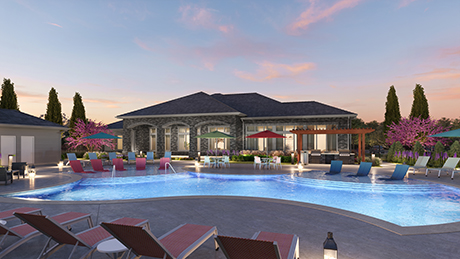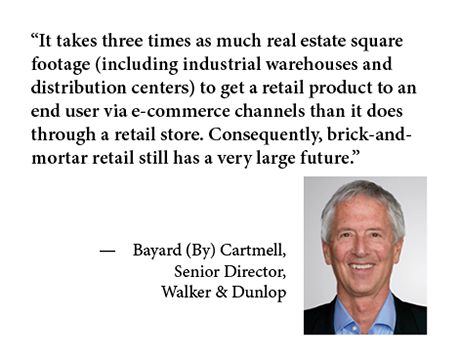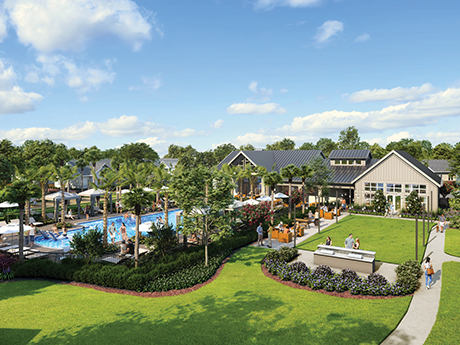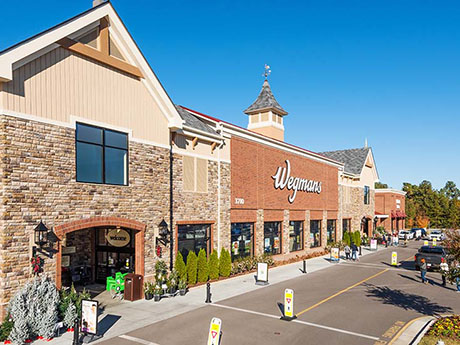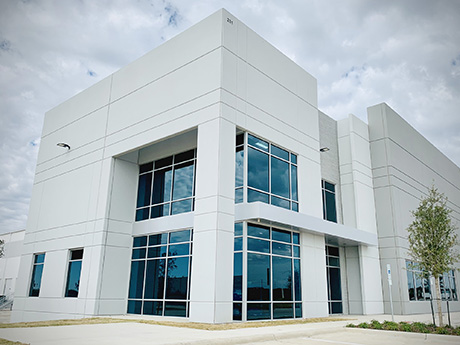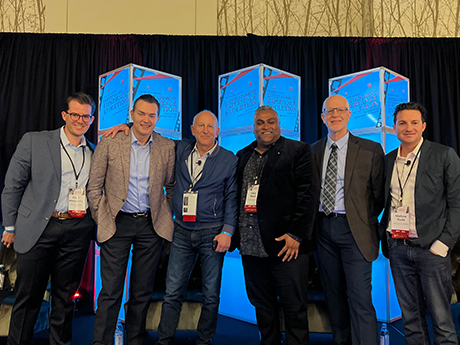CHARLOTTE, N.C. — During the closing panel at France Media’s InterFace I-85 Industrial Corridor conference, brokers from the major markets along the 666-mile interstate gave updates about developments and opportunities in their territories. Brockton Hall, vice president of Colliers’ Upstate South Carolina office, said that the Greenville-Spartanburg industrial market in South Carolina had 16 million square feet of industrial space under construction, which represents an inventory growth of approximately 7.4 percent. Graham Stoneburner, senior vice president of Cushman & Wakefield, said that the Richmond, Va., market currently had 11 million square feet underway, which represents an inventory growth of 11 percent. Similarly Robbie Perkins, shareholder and market president at NAI Piedmont Triad, said North Carolina’s Triad region had 8.7 million square feet in the development pipeline, a nearly 11 percent growth rate compared to the market’s 80 million-square-foot inventory. During nearly every panel throughout the conference, which was held on Wednesday, April 13 at the Hilton Uptown Charlotte, brokers, investors and developers described the industrial growth along the I-85 Industrial Corridor as “unprecedented.” “There’s a real lack of supply at the moment, but we have a lot coming,” said John Montgomery, managing director of Colliers’ Upstate South Carolina office, during …
Features
AlabamaConference CoverageFeaturesGeorgiaIndustrialNorth CarolinaSouth CarolinaSoutheastSoutheast Feature ArchiveVirginia
As the pandemic recedes, unusual supply and demand trends have taken root in retail and industrial markets throughout the nation. Factors that caused upheaval even before the arrival of COVID — the changing face of retail due to e-commerce and the growing demand for industrial real estate — continue unabated two years past the pandemic lockdowns. Los Angeles County may act as a bellwether for the rest of the country in retail and industrial trends, especially in high-cost, high-density areas, where these two real estate types often compete for space. Bayard (By) Cartmell, senior director at Walker & Dunlop, Los Angeles, has extensive experience with commercial real estate in the Los Angeles area. He has seen unprecedented demand for industrial space and growing investor interest in retail cap rates in the Los Angeles area. Cartmell sat down with REBusinessOnline to talk about the outlook for industrial and retail in Los Angeles, their intersections and the sector trends he expects to see in the coming year. Los Angeles Industrial — High Demand REBusiness: What are you seeing in terms of demand for industrial space — particularly in Los Angeles? Cartmell: There is currently almost unlimited demand for industrial space, of any size, …
By Kenneth Katz, co-founder and principal, Baker-Katz The COVID-19 pandemic has reshaped the commercial real estate landscape, and retail has been no exception. Over the past two years, Americans have flocked to rural and suburban communities on the outskirts of major cities, seeking lower living costs and a better quality of life. An uptick in demand for residential real estate followed, and hot on its heels came increased demand for new retail and restaurant spaces to serve growing populations. Done right, retail construction can meet the emerging needs that migration trends expose, bringing new life and vitality to communities. Intelligent, efficient development practices can bring major retailers to consumers who would have previously traveled further afield, costing the city revenue. However, not every site or project is workable. Developers need to identify the right location — and the right moment. In January 2021, Houston-based Baker Katz broke ground on Brenham Crossing, a 50-acre, 250,000-square-foot shopping center in Brenham, Texas. Nestled midway between Houston and Austin, with a population of close to 75,000, Brenham and the surrounding area quickly attracted new residents as more Americans sought temperate climates and a more accessible housing market. In 2021, Texas topped U-Haul’s growth index …
If there were any doubt that student housing stakeholders were quickly moving into the single-family build-to-rent market, the question was just settled for good. Chicago-based Harrison Street, one of the industry’s biggest players, recently announced a blockbuster deal to form a joint-venture with Core Spaces, one of student housing’s biggest developers. But this venture isn’t about student housing; it will invest up to $1.5 billion in subdivisions with hundreds of rental homes in markets such as Austin, Denver, Dallas, Orlando and Nashville. “We had an ah-ha moment,” says Justin Gronlie, managing director and Head of Education Real Estate at Harrison Street. He explains that Harrison Street was among the first firms to invest cottage-style student housing back in 2007, and since then, has developed and acquired more than 27 BTR-style student housing communities comprising 19,000 beds. The off-campus single-family style homes in highly amenitized developments are similar to the product in build-to-rent communities. “Due to our unique experience and track record in student housing, we recognized the patterns and magnitude of the BTR opportunity in front of us and pounced at it,” says Gronlie. Like student cottage projects, build-to-rent (BTR) or build-for-rent (BFR) developments offer detached units, townhomes or …
Three Keys for Shopping Center Owners to Remember When Protesting Property Tax Assessments
by John Nelson
Property owners should receive a Notice of Appraised Value from their appraisal district by mid-April. This year, it is imperative that retail property owners submit an assessment protest prior to the deadline and help to establish fair taxable valuations in the post-pandemic marketplace. Since March 2020, COVID-19 has brought uncertainty and ongoing challenges to real estate owners. People often discuss the commercial real estate “winners and losers” of COVID-19, and of the four commercial real estate food groups, retail certainly suffered one of the heaviest initial blows. But how has the property type recovered as the pandemic has evolved? This article explores where exactly retail falls, and then offers strategies to argue more effectively for reduced assessments. Evolving trends To develop a full picture of the current state of shopping centers, one must look back to 2019 and early 2020 before the pandemic. In 2018, approximately 5,800 retail stores closed nationwide and only 3,200 opened, for an overall deficit of 2,600 locations. In 2019, the size of the annual store deficit nearly doubled with 5,000 more closures than openings. E-commerce sales volume rose steadily from 2010 through 2019, which, coupled with accelerating physical store closures, clearly indicate a slowdown in …
By Steve Firestone, Crown Bay Group Why would anyone choose investing in an aging workforce housing property over razing it to make room for Class A apartments? Are these challenging properties worth the risk? Making this choice may not be right for everyone, but the returns can be unbelievably rewarding. The secret recipe for transforming Class B and C properties to benefit the community, local residents and your bottom line isn’t complicated. The key is entering into each deal with a genuine interest and desire to do what is right and what matters to the residents who call this property home. The age-old saying — by doing good, you will do well — still holds true today. There is an overwhelming demand for Class B and C assets. While a large portion of new development over the past decade has been Class A luxury, the Class A market makes up only 20 percent of the total rental market. New construction of affordable, market-rate units is just not financially feasible today. Consequently, meaningful workforce supply has rarely been added this past decade. Despite the pervasive need for workforce housing, the supply has decreased with older units being demolished to make room …
SANTA BARBARA, CALIF. — The national average for in-place industrial rents across the top 30 U.S. markets reached $6.45 per square foot in February, a 4.4 percent year-over-year increase according to research from CommercialEdge, a product of Yardi Systems. The Santa Barbara-based firm found that the average effective rental rates signed over the same interval was $7.35 per square foot, 90 cents higher than the national average for in-place leases, a nearly 14 percent swing. Southern California markets led the nation in rent expansion, largely due to intense activity in the Ports of Los Angeles and Long Beach. Orange County recorded the most significant 12-month change with a 7 percent hike, reaching $11.65 per square foot. Los Angeles (6.7 percent) and the Inland Empire (6.5 percent) rounded out the top three markets nationally. On the other end of the spectrum, markets that have higher availability of developable land recorded weaker rent growth in the last 12 months. Newly delivered stock in these markets is helping developers meet demand, while also elevating vacancy levels. Across the top 30 U.S. markets, rent growth was slowest in Charlotte (1.1 percent), Houston (1.7 percent) and Indianapolis (2.3. percent). The spread between the average lease …
By Taylor Williams With the COVID-19 pandemic largely in society’s rearview mirror and warm weather months approaching, Americans are fired up to recoup lost time at their favorite restaurants, bars and entertainment venues. But the collision of this pent-up demand with 40-year inflationary highs means that many consumers are going to be more selective about where they eat, drink and source entertainment. To that end, meals, drinks, games and activities must offer a truly unique experience to justify consumer spending of their stretched dollars and to capture the Holy Grail of repeat spending/visits. That’s not to say that run-of-the-mill, traditional food and beverage (F&B) and entertainment concepts won’t rebound to some extent. But the concepts that deliver their offerings to customers in ways that are truly unique and memorable will be the ones that recognize the strongest sales growth and build the most enduring brand loyalties. Strategies, philosophies and exemplary practices that go into making this endeavor a reality were at the forefront of a panel discussion at the seventh-annual Entertainment Experience Evolution conference that took place in mid-March in Los Angeles. Hosted by Shopping Center Business, the flagship publication of Atlanta-based France Media Inc., the event drew more than …
Where do people go to “get away from it all” — especially when the world shuts down? Many seek relaxation and recreation in the great outdoors. Interest in camping — especially the subset of high-end camping often referred to as “glamorous camping” or “glamping” — grew steadily in the years before the pandemic. The arrival of COVID and the desire for socially distanced vacations created a rapid increase in demand and revenue. The result for commercial real estate has been a large increase in the number of investors interested in outdoor hospitality properties. “Before 2020, the trend was already very strong; the pandemic just accelerated it,” says Sean Wood, associate broker at NAI Outdoor Hospitality Brokers. Wood cites the Kampgrounds of America (KOA) 2021 Annual North American Camping Report: “From 2014 to 2018, there was consistent growth of about 2 million new households per year getting into camping across North America. From 2018 to 2019, we saw a jump from 39.2 million to 41.9 million households that went camping. And then in 2020, we saw an explosion in interest: from 41.9 million households to 48.2 million households camping each year.” The specialists at NAI Outdoor Hospitality Brokers expect this renewed …
When it comes to commercial real estate development, thoughtfully curated teams are critical to success. “It’s important that the extended team works well with each other, so they can deliver results for clients,” explains Mark Fletcher, director of Strategic Partnering at Bohler, a land development design and consulting firm. Developers don’t want to work with a variety of disjointed processes and personalities. They want to work with one team, a multi-discipline team that effectively manages time and resources, focusing on streamlined processes and speed to market. This sort of team unity promotes both cohesiveness and consistency in outcomes. Building a great design and consulting team means having the property developer’s end goals in mind from the very start of the process: dependability, speed to market and turnkey solutions. The importance of fostering cohesion extends to finding an architect to optimize the building and a contractor to strategize materials and phasing. It may be necessary to engage an attorney who can work well with the team to address land use and zoning. Finally, the right site design and consulting firm can streamline communications, maintain timelines and entitlements and keep the project moving forward. Here’s how Bohler’s approach to assembling a team …


